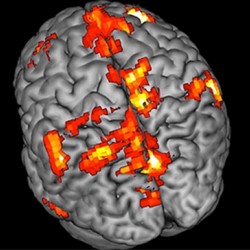By Helen Figueira
July 9, 2014
Time to read: 3 minutes
 How the levels of a serotonin brain receptor may affect how we respond to fearful situations
How the levels of a serotonin brain receptor may affect how we respond to fearful situations
In a study published in Biological Psychiatry, Professor Oliver Howes from the MRC Clinical Sciences Centre’s (CSC) Psychiatric Imaging Group, applied brain imaging techniques to show how levels of the serotonin receptor, 5-HT1a, may explain why some people are more sensitive to aversive, especially fearful, emotions than others. This is the first time researchers have pinpointed 5-HT1a as an important factor in how we process fear.
Serotonin (5-HT) is a neurotransmitter key in regulating and processing emotions and mood; dysfunction in the serotonin system is linked to depression and other mood disorders. While studies in animals have implicated 5-HT1a to have a particularly important role in regulating response to fear, explorations in humans have, until now, only yielded inconclusive results.
5-HT1a receptors are located on the cell body of serotonin nerve cells and regulate the firing of serotonin throughout the brain. To determine what role these receptors have in emotional processing, Howes’ team enrolled healthy human participants to undergo position emission tomography (PET) scanning and functional magnetic resonance imaging (fMRI) on site at Hammersmith Hospital.
The group administered a tracer that binds specifically to 5-HT1a and applied PET to visualize receptor levels in the volunteers. FMRI was used to monitor brain activity in response to various stimuli. When certain parts of the brain are activated, blood flow to that area increases; fMRI can pick up such changes using the blood-oxygen-level dependent (BOLD) contrast. The brain’s response to processing happy, neutral and fearful faces was analysed to show that those with lower levels of 5-HT1a react more strongly when presented with fearful stimuli.
The way we process emotions is conducive to determining our mood. Howes is now keen to build on the findings to better understand receptor activity in mood disorders. “Because 5-HT1a receptor levels affect only the processing of negative emotions, it indicates to us that these receptors will have an important role in mood disorders,” explains Oliver. What’s more, localising one receptor within the serotonin system that is responsible for regulating aversive emotional processing will help guide the design of receptor-specific drug targets, offering a novel route in the treatment of mood disorders.
YJ
Reference: Selvaraj, S., Mouchlianitis, E., Faulkner, P., Turkheimer, F., Cowen, P. J., Roiser, J. P., Howes, O., (2014). Presynaptic serotoninergic regulation of emotional processing: A multimodal brain imaging study. Biological Psychiatry, S0006-3223(14)00295-9.
This work was supported by the Medical Research Council.
The Medical Research Council has been at the forefront of scientific discovery to improve human health. Founded in 1913 to tackle tuberculosis, the MRC now invests taxpayers’ money in some of the best medical research in the world across every area of health. Twenty-nine MRC-funded researchers have won Nobel prizes in a wide range of disciplines, and MRC scientists have been behind such diverse discoveries as vitamins, the structure of DNA and the link between smoking and cancer, as well as achievements such as pioneering the use of randomised controlled trials, the invention of MRI scanning, and the development of a group of antibodies used in the making of some of the most successful drugs ever developed. Today, MRC-funded scientists tackle some of the greatest health problems facing humanity in the 21st century, from the rising tide of chronic diseases associated with ageing to the threats posed by rapidly mutating micro-organisms. www.mrc.ac.uk